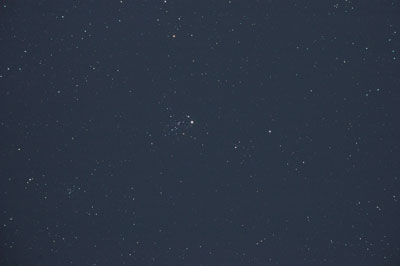The distinctive W or M of Cassiopeia lies entirely in the Milky Way and is known for its open clusters. In the vicinity of κ Cassiopeiae, Tycho Brahe discovered a supernova in the year 1572, and he studied it for 16 months before it was too dark for the naked eye.
γ Cassiopeiae is the namesake of a whole class of variable stars which are also referred to as shell stars. These blue giant stars rotate so fast that they constantly lose some of their mass, leading to unpredictable fluctuations in brightness. The 613 light-years distant star therefore appears 1.6 to 3.0m bright.
M 52 contains nearly 200 stars and is one of the richest open clusters. In binoculars, only a part of its stars can be resolved, the rest are blurred to a 13 arcmin wide shimmer. The 3,900 light-years distant group has a diameter of 14 light-years. In its center are about 50 stars per cubic parsec. The stars vary in age from 50 to 150 million years.
The Owl Cluster NGC 457 is located northwest of the 5.0m bright φ Cassiopeiae. The 13 arcmin large star cluster contains two star arcs, which can easily be resolved. The brightest star reaches 8.6m. 9,300 light-years separate us from this group, which is located in the neighboring Perseus arm of our Milky Way. NGC 457 was formed about 25 million years ago. φ Cassiopeiae is a 2,300 light-years distant foreground star that shines 4,400 times brighter than our Sun. Another star of seventh magnitude is also in the same line of sight as the star cluster.

The open cluster NGC 663 can be resolved in binoculars into several smaller groups of stars. However, the brightest of its 80 stars reach only ninth magnitude, so that the 16 minutes of arc large star cluster requires a dark sky. Otherwise, you are at best able to observe a small nebula. NGC 663 is located about 1° southeast of the center of the connecting line between ε and δ Cassiopeiae, 23 arc minutes southeast of a 6.3m bright star.
Stock 2 is also known as the Muscle Man Cluster and would certainly be observed more often if it were not so close to the magnificent pair of h and χ Persei in the neighboring constellation Perseus, which draw all attention to themselves. Even at low magnification you can resolve many of the 50 stars that make up the 1° large open star cluster. The other stars blur into a shimmer that fills the background. At a distance of only 1,050 light-years, its diameter is 18 light-years. With an age of 170 million years, Stock 2 is one of the older star clusters.
